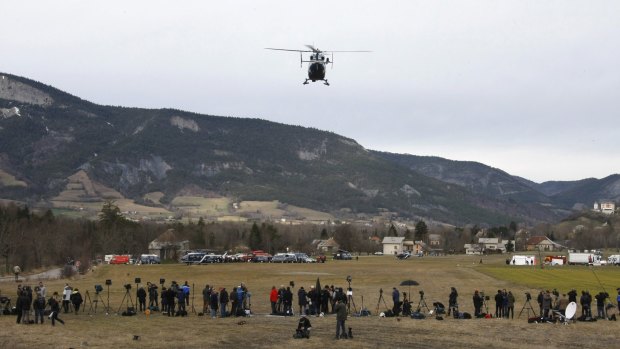This was published 9 years ago
Germanwings crash: Terrorism unlikely as cause of plane crash, says interior minister Bernard Cazeneuve
Paris: France's interior minister has apparently ruled out a terrorist attack as the cause of the Germanwings air crash in the French Alps.
However, at least one expert has said a problem known to affect the Airbus may have caused flight 4U9525 to plough into an alpine mountainside while flying over France en route to Dusseldorf from Barcelona.

A rescue helicopter taking off from Seyne-les-Alpes, France, to search for the 150 victims who died.Credit: AP
"The debris from the plane is spread over one and a half hectares, which is a significant area because the shock was significant," Bernard Cazeneuve told French radio station RTL the morning after the disaster, on Wednesday.
"But it shows that the plane did not appear to have exploded."
The theory of a terrorist attack is "not the theory we're focusing on", Mr Cazeneuve said.
Nevertheless, the minister added cautiously that "all theories must be carefully examined until we have the results of the enquiry".
He said the black box that had been recovered from the crash site, which records the sounds and conversations in the cockpit, had been damaged and would need to be repaired "in the coming hours".
"The enquiry must begin today," Mr Cazeneuve stressed.
Early on Wednesday, investigators began the grim task of sifting through the pulverised remnants of the Airbus A320, which smashed into the French Alps, killing all 150 people on board.
Their efforts are being hampered by the inaccessibility of the crash site, with helicopters finding it near impossible to land in the rocky and perilously steep mountain terrain.
US-based aviation lawyer and pilot Arthur Alan Wolk said it was possible the "angle-of-attack sensors" at the front of the plane had iced over, causing the aircraft to "go pretty much straight down".
"If there was no foul play, then this looks like another example of the angle-of-attack sensors in the front of the airplane being iced over and closing the autopilot that caused this airplane to go pretty much straight down," Mr Wolk told Fairfax Radio 3AW.
"There was a bulletin issued just last December which confirms a problem found in Airbuses with those angle-of-attack indicators that generates just this kind of problem," he said.
An "angle-of-attack indicator" tells the aircraft's autopilot system in which direction the nose of the plane is facing.
Mr Wolk said the same problem caused the Air France Flight 447 disaster in 2009, in which 228 people died when the plane crashed into the Atlantic Ocean en route to Paris from Rio de Janeiro.
"This is a serious problem ... the crew can't get up to pull the circuit breaker on the autopilot and the other electronics without leaving their seat, so there's nothing in front of them, nothing handy for them to address this problem and make it go away," he said.
A Lufthansa flight from Bilbao to Munich on November 5 lost altitude after sensors iced over and the onboard computer, in expectation the plane was about to stall, put the nose down, Reuters has reported. As a result, the European Aviation Safety Agency ordered a change in procedure for all A320 jets.
Asked whether something similar could have occurred on Tuesday, Germanwings managing director Thomas Winkelmann said, "At this time this evening, we are ruling out a possible cause in this area."
Australian aviation analyst Neil Hansford told 3AW, "You can't rule anything in and you can't rule anything out because it's just too early."
He said the circumstances of the crash were between "two ends of the spectrum" usual to airline accidents.
"To take eight minutes to go down 30,000 feet ... if it was a catastrophic explosion, it would've gone down quicker than that. If it was a loss of power, it would have glided for longer than that," he said.
AFP